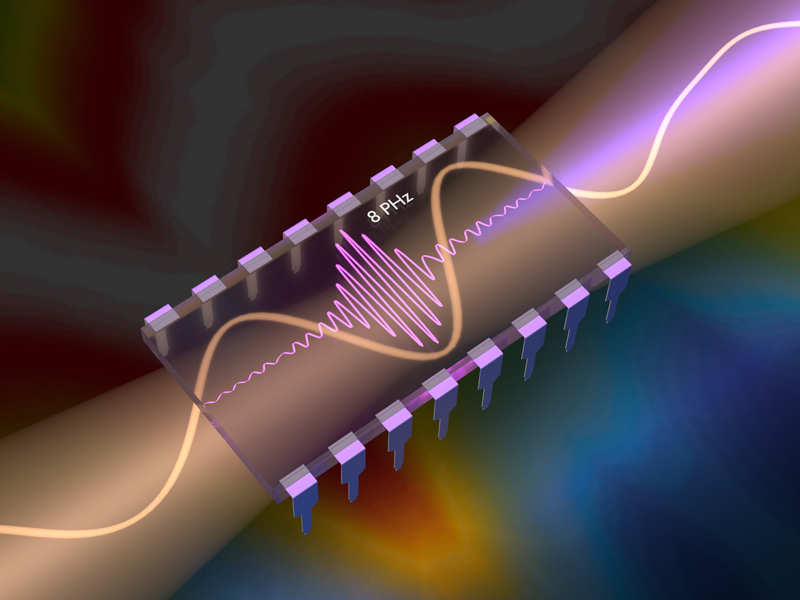

Light pulses generate Multi-PHz electric current in bulk solids. The emitted extreme ultraviolet radiation allows scientists to record these electric currents in real time.
Graphic: Research Group Attoelectronics, MPQ
The performance of modern electronic devices such as computers or mobile phones is dictated by the speed at which electric currents can be made to oscillate inside their electronic circuits. The shrinkage of basic electronic elements, such as transistors, to smaller and smaller dimensions over the last decades has allowed the development of ever-faster electronic devices like the ones used in everyday life.
However, this methodology of speeding up electronics is now rapidly approaching its ultimate limits; devices are becoming nearly as small as only a few atoms (!) and conventional principles of electronic technology hardly apply in these dimensions, calling for new routes to be discovered.
A team of scientists led by Dr. Eleftherios Goulielmakis, head of the “Attoelectronics” research group at the Max Planck Institute of Quantum Optics, have been able for the first time to use lasers to create electric currents inside solids which exceed the frequency of visible light by more than ten times. This work is published in Nature (20 October 2016, DOI: 10.1038/nature19821).
The scientists used silicon dioxide, a material that is typically used as an insulator in the electronic industry aiming to stop rather than to allow electric currents in its bulk. However, when this material was exposed to intense lasers the conductivity was increased by more than 19 orders of magnitude enabling new opportunities for modifying the properties of material on an ultrafast time scale.
“The possibility of having light replace conventional sources of electricity, such as batteries in order to generate electric currents inside solid materials, like those used in the electronic industry, has captured the imagination of scientists for more than a century,” explained Eleftherios Goulielmakis. In his Nobel lecture, Karl Ferdinand Braun, the inventor of the first solid-state electronic device—the rectifying diode—alluded to his unsuccessful attempts to observe currents in solid materials by shining light on them.
“Today, however, as control of matter with lasers is rapidly advancing and the capability to measure light fields with ever finer precision has turned to reality, the idea of using lasers for guiding the motion of electrons inside solids such as to create high frequency electronic currents is rapidly gaining momentum,” Goulielmakis adds.
Conventional electronic techniques can neither generate nor capture such fast electric currents. Scientists in the Attoelectronics group used another approach. “To generate the currents we used lasers, as they can set electrons in solids into an extremely fast oscillatory motion,” explained Manish Garg, a graduate student and leading author of this work. But why can lasers bring such an advance?
In conventional circuits, electrons are pushed by the electric field of standard electric sources, such as batteries to perform oscillations. Even though all electrons initially follow the force of the battery fields, they eventually collide with other slower moving particles such as atoms or ions and lose their synchrony with each other. Intense light fields can push electrons extremely fast. They can perform their oscillations and create currents before any other particle in the solid has the opportunity to move.
“To measure this fast electronic motion, we used optical techniques. Instead of directly measuring the electric currents, we measured the oscillations of the extreme ultraviolet radiation emitted as the electrons coherently oscillate inside silicon dioxide to generate this radiation,” he adds.
The detected electric currents are approximately one million times faster than those widely used in a modern computer processor. “Although our focus is to explore the physical limits, our study may open the way of speeding up future electronic devices by a million times in the years to come,” said Minjie Zhan a researcher in the group of Dr. Goulielmakis. “Our work opens up the route to realizing coherent electronics in bulk materials, an idea earlier conceivable only for isolated molecules. As electrons move coherently they also generate light which is the key element of photonics. For this reason it may soon allow us to unify two important areas of modern science and technology, electronics and photonics,” Goulielmakis adds.
Original publication:
M. Garg, M. Zhan, T. T. Luu, H. Lakhotia, T. Klostermann, A. Guggenmos & E. Goulielmakis
Multi-petahertz electronic metrology
Nature, 20 October 2016, DOI: 10.1038/nature19821
Contact:
Dr. Eleftherios Goulielmakis
ERC Research Group Attoelectronics
Max Planck Institute of Quantum Optics
Laboratory for Attosecond Physics
Hans-Kopfermann-Str. 1
85748 Garching, Germany
Phone: +49 (0)89 32 905 -632
E-mail: eleftherios.goulielmakis@mpq.mpg.de
Dr. Olivia Meyer-Streng
Press & Public Relations
Max Planck Institute of Quantum Optics, Garching, Germany
Phone: +49 (0)89 32 905 -213
E-mail: olivia.meyer-streng@mpq.mpg.de
http://www.attoworld.de/goulielmakis-group












